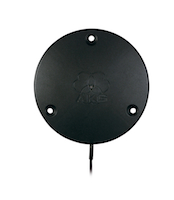

Boundary Microphones and Automatic Mic Mixers Technology Showcase
Aug 29, 2011 2:39 PM,
by Bennett Liles
AKG CBL 99
Boundary, or pressure zone, microphones are seeing a rapid expansion in use with the spreading deployment of various conferencing applications. Classrooms, conference rooms, and mobile meeting AV packages have brought about new models and features in this type of microphone.
The CBL 99 boundary mic from AKG is equipped with three screw holes for permanent, secure mounting, and it features a switchable 150Hz bass-cut filter to limit the transfer of mechanical bumps and thumps from the mounting surface. Only 0.2in. thick, the matte black disk provides an omnidirectional pattern it operates on 9V-52V phantom power. Optional accessories include a battery-operated power supply and a phantom power adapter cable.

Astatic Commerical Audio Products 220VP
The 220VP boundary mic is part of the 2220VP microphone system from Astatic Commercial Audio Products, and it provides continuously variable polar pattern control by way of a two-conductor shielded cable from the mic head to a DSP unit. Mounted in a 15/16in. hole, the mic is designed to resist interference from cell phones, two-way radios, and other RF devices while the shock-absorbing bushings allow installation in surfaces up to 3in. thick. The unit has a maximum SPL rating of 120dB and is available in either matte black or white.

Audio-Technica es945
Audio-Technica designed the es945 boundary mic for omnidirectional pickup in permanent surface-mount applications for ceilings, tabletops, and wall panels. Equipped with UniGuard RFI-shielding technology, the unit is available in a white or black case. It runs on 11V-52V phantom power and features a die-cast case and a two-layer steel mesh grille. The microphone offers a frequency response of 40Hz to 18kHz, a dynamic range of 112dB, and can handle sound pressure levels up to 142dB.

Audix M60
Featuring superior RF immunity in a very heavy-duty shock resistant design, the new M60 boundary microphone from Audix provides fully integrated low-noise circuitry and a balanced signal at the mic source. The mic is optimized for voice response with a hemi-cardioid directional pattern, and the cable can be attached either on the bottom or on the edge opposite the pickup element. The unit is available in black, white, or nickel.

Beyerdynamic MPC 67
The MPC 67 boundary mic from Beyerdynamic features a half-cardioid polar pattern and a switchable frequency response along with an 8-bit micro controller that provides a number of functions. The unit can be operated with the push of its noiseless film button in three modes, on/off, push-to-talk, and push-to-mute. The frequency response can be set for linear, 80Hz roll off or 180Hz roll off. The top-mounted LED indicates when the mic is on.

Clockaudio CRM100-RF
In its retracted position, the ClockaudioCRM100-RF omnidirectional condenser mic appears almost like a coin lying on the conference table, but when it is pressed and raised, the microphone offers a built-in RF filter, balanced audio output, and 30Hz to 20kHz frequency response. Operating on 9V-48V phantom power and designed for remote switching, the mic is available in either black or nickel finish and includes a 6.5ft. low-impedance cable.
Consisting of a central black rubber disc surrounded by a stainless steel case, the BLM4060 boundary mic from DPA Microphones can be customized with a number of adapters and operates on 48V phantom power. The microphone comes with a black 10ft. power cord and the omnidirectional pickup pattern allows a 6dB gain of direct sound with only 3dB gain of diffuse sound. The unit can handle up to 134dB sound pressure levels before clipping and rises only 0.5in. above the surface on which it is placed.
1
Boundary Microphones and Automatic Mic Mixers Technology Showcase
Aug 29, 2011 2:39 PM,
by Bennett Liles

Electro-Voice PC Boundary Satellite
Presenting a choice of polar patterns including omnidirectional, cardioid, supercardioid, and figure-eight selected on a four-position rotary switch, the PC Boundary Satellite microphone from Electro-Voice goes wireless by fitting any current EV or Telex wireless body pack transmitter inside. The dual condenser, back electret element provides a frequency response of 50Hz to 20kHz and 130dB SPL figure. On the case is a membrane button for on/off, push-to-mute, or push-to-talk functions.

Nady CBM 40X
Intended for applications such as pickup on orchestras, choirs, stage performances, courtrooms, and conferences, the well-proven CBM 40X half-cardioid boundary microphone from Nady Systems includes a 16ft. mini-XLR-to-XLR cable and operates on 9V-52V phantom power. The die-cast metal alloy case can also be wrapped in a blanket and placed inside a kick drum, relying on its 130dB SPL capability. The Nady 48V SMPS-1X phantom power supply is available as an optional accessory.

Peavey PSM3
Designed by Peavey for picking up stage performances, videoconferences, and other boundary mic applications, the PSM3 exhibits a half-cardioid pickup pattern with a frequency response of 50Hz to 20kHz, a dynamic range of 106dB, and a maximum SPL figure of 130dB. The mic has a black non-reflecting finish and sits on a shock-absorbing mounting pad. The low-impedance cable is detachable, and the back electret condenser element operates on a 9V-52VDC phantom power source.

Sennheiser e912
The e912 pre-polarized half-cardioid boundary microphone from Sennheiser is intended for piano pickup, stage productions, conferences, podiums, and lecterns. It features a shock-absorbing rubber base, mounting slots for table installation, integrated pre-amp, and a gold-plated XLR connector. The unit runs on 48V phantom power and provides 20Hz to20kHz frequency response. The maximum SPL is 135.6dB, and the microphone is available in either black or white finish.

Shure MX690
Offering unlimited movement and placement options, the MX690 wireless boundary microphone from Shure runs on two AA batteries and is compatible with Shure SLX wireless systems including the SLX4L receiver with logic output for applications requiring logic functionality. The transmitter is frequency agile, and the unit includes a bi-color status indicator, an IR link to the SLX receiver for automatic frequency synchronization, programmable mute function, and a battery level indicator. The mic provides 15Hz to17kHz frequency response, and it will operate for up to eight hours on alkaline batteries.

TOA Electronics EM-700
TOA Electronics equipped the EM-700 boundary mic with a 100Hz 12dB/oct low-cut filter switch on the bottom for best performance in environments with room rumble while the cardioid pickup pattern further reduces background noise. Running on 9V-52V phantom power, the microphone offers a 35Hz-20kHz frequency response with the low-cut filter off. The body is black die-cast aluminum with a rugged metallic punched net top screen. It is supplied with a 24ft. cable and XLR connector.
Automatic Microphone Mixers
These have been around for quite a while, but their new resurgence, like that of boundary mics, has been largely triggered by the take off of the conferencing market. At the same time, staff levels are thinning and everything automatic is getting a serious look.

AKG Acoustics DMM 4/2/4
Equipped by AKG Acoustics with an algorithm that includes NOM (number of microphones) attenuation, noise detection, and a noise-sensitive threshold function, the DMM 4/2/4 automatic microphone mixer provides four mic/line and two stereo aux inputs, switchable phantom power on each channel, and dbx compression/limiting. Each level knob has an incremental circular LED indicator and peak hold display. Each input also has low cut, LF shelving, and HF shelving filters. The mixer has a rear-panel RS-232 control port along with main stereo, recording, and headphone outputs.
2
Boundary Microphones and Automatic Mic Mixers Technology Showcase
Aug 29, 2011 2:39 PM,
by Bennett Liles

Audio-Technica AT-MX351
The Audio-TechnicaAT-MX351 is a 1RUsolution to automatic mixing of up to four microphones featuring individually selectable 48V phantom power, limiters on each mic channel, pre or post-controller audio outputs for each channel, and a TTL output and closure control input for remote control. NOM attenuation operation is included and can be turned on or off. The unit includes a headphone output with level control, an output level meter with peak, and RMS modes in addition to balanced inputs and outputs with switchable mic/line input levels.

Handling eight microphones in a 1RU chassis, the autoTwo from Biamp uses plug-in barrier connectors and features NOM attenuation, adaptive threshold sensing, selectable last mic on, and 48V phantom power. There are main and aux outputs along with stacking capability for two units. Each channel includes trim, pad and level control, combined active/peak LED, and an unbalanced direct output. On the rear panel are DIP switches to select gating, phantom power, and direct out pre/post gate.
Multiple functions, connection variety, and programming versatility are hallmarks of the Converge SR 1212A from Clearone. The digital matrix mixer is a 12-input, 12-output device with four integral 35W power amplifiers that connect to 8Ω or 70V speakers. Featuring Dynamic Automatic Resonance Elimination (DARE), ALC, AGC, and advanced digital processing on each amplifier channel, units can be linked to handle up to 96 microphones and 16 telephone lines for conferencing, training, courtrooms, churches, zoned paging, and other applications.

Clockaudio MR88
The ClockaudioMR88 is a DSP-microprocessor-controlled automatic switching 8-channel mic mixer with balanced low-impedance XLR inputs and balanced stereo outputs that can be switched to mic or line level. The rear-mounted VCA connector allows access to the open-collector outputs and the internal control inputs. For connection to stereo gear there are also RCA -10dB level output connections. Multiple units may be daisy chained through RCA linking ports.

Dan Dugan Sound Design Model E-1
The most recognizable name in auto mixing is Dan Dugan Sound Design and Dan’s latest entry is the Model E-1 automatic mixing controller with three methods of unit control. These are the front panel, the Web control panel, and the serial connection. Internal flash memory stores all four programs associated with the device operation, and the DSP firmware embodies the Dugan Speech System Algorithm. The unit can connect to the interstage patch points of an existing mixer to convert it to the automixing functions. Multiple units may be linked to act as one larger automatic mixer.

Lectrosonics SPN 1624
Taking configuration and function versatility to a new level, the SPN 1624 from Lectrosonics is one of several models in the Aspen line of mixers that provide a crosspoint matrix; master/slave input expandability; control by RS-232, USB, Ethernet, and the unit’s logic I/O ports. Each input is adjustable from -10dB to +60dB and a single Cat-6 connection carries data, audio, and control signals. Multiple automatic mixing and recording modes enable each input to behave differently at each output.

Peavey Sanctuary Series S-4
The PeaveySanctuary Series S-4 provides four XLR mic and 1/4in. line level inputs in a 1RU chassis that includes 48V phantom power, selectable microphone priority, a soft-knee compressor with variable threshold, and a PFL switch on each channel for setup and testing. Individual channels also have a signal activity and peak indicator, a low-cut filter, channel insert or direct output 1/4in. connection, and an automatic/manual operation switch on inputs 3 and 4.

Rane AM2 Automixer
The AM2 Automixer from Rane can play a dual role in that it offers an eight-input standalone automixing unit with XLR connectors and individual signal and output indicator LEDs, but in addition it can use the remote audio device (RAD) port to send the mic mix over a Rane Mongoose or CobraNet network. Optimized for speech, the AM2 has a fixed 100Hz to 7kHz bandpass filter, and the main XLR output port can be set to either line or mic level. Cascade in/out connections enable each unit to be part of a larger coordinated mixing setup.

Shure SCM410
One of the most familiar members of the small automatic mic mixer group is the SCM410 4-channel mixer from Shure with its input gain knobs flanked by screwdriver-adjustable equalizer controls. The half-rack chassis includes a balanced mic/line output and an RCA auxiliary out connector. A last mic on lock-on circuit maintains ambient sound, and the mixing logic automatically adjusts for background noise. The front panel includes bi-color-channel activation and clipping LEDs along with a peak responding LED output level meter.

Symetrix Automix Matrix 780
Symetrix designed the Automix Matrix 780 for maximum versatility in a minimum space. The 1RU mixer includes eight mic/line and four line-only inputs along with compression, AGC (gating and gain sharing), matrix mixing, feedback elimination, filters, EQ, limiting, and delay. Front-panel controls and indicators are amply augmented by the software interface, which displays a graphical mixer with all of the unit’s functions. The eight outputs can be fed in any combination for a wide variety of mix feed scenarios.

TOA Electronics D-901
The D-901 from TOA Electronics is a digital mixer with 12-input, eight-bus, and 8-channel output functionality that also incorporates a feedback suppressor and automatic mixing based on NOM attenuation. A ducker drops the level of other inputs when one channel is active. A built-in compressor can be used along with flexible speaker crossover points and filter slopes. The unit can store up to 16 configuration presets for instant recall by front-panel buttons, and the settings can be locked. The eight-bus matrix allows flexible input-to-output signal routing for zoning and room combining.
3










